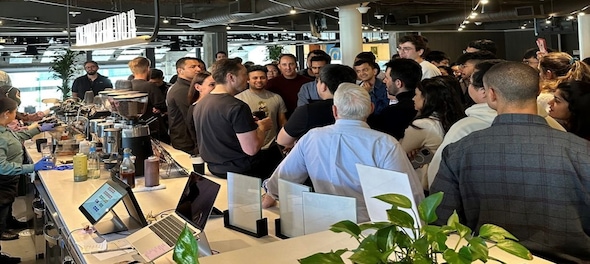
Elon Musk took control of Twitter before the court-ordered deadline and reportedly fired its top executives. According to reports, the "Chief Twit" has terminated Chief Executive Officer Parag Agrawal, Chief Financial Officer Ned Segal, and legal affairs and policy chief Vijaya Gadde.
Musk had accused them of misleading him, and Twitter investors over the number of fake bot accounts on the microblogging platform.
Agrawal and Segal were in Twitter's San Francisco headquarters when the deal closed and were "escorted out" following their termination, according to The Times of India. None of those "fired" has changed their designations on their official Twitter handles, though, until the time of publishing this story.
The $44-billion acquisition deal of Twitter is the culmination of a saga which was full of twists and turns. Musk finally came through with the deal on October 27, a day before the court-ordered deadline.
The takeover story began on April 4 and stretched till October 27. Here’s a look at the timeline of the Musk-Twitter takeover story.
January 31:
Musk starts increasing his stake in Twitter, amassing a 5 percent stake in the company by mid-March.
March 26: Musk takes to Twitter to say he is giving "serious thought" to building an alternative to Twitter, questioning the platform's commitment to "free speech" and commitment to democracy.
March 27: Musk privately informs Twitter of his growing stake in the company and starts conversations with its CEO and board members about potentially joining the board. In regulatory filings, Musk mentions taking Twitter private or starting a competitor.
April 4: A regulatory filing reveals that Musk has become the largest shareholder of Twitter with a 9 percent stake, or 73.5 million shares, worth about $3 billion.
April 5: Musk is offered a position on Twitter's board with the condition that he could not increase his stake more than 14.9 percent of the company's stock. CEO Parag Agrawal tweeted that Musk would be joining the board.
April 9: Musk tweets saying, "Is Twitter dying?". Agrawal calls the criticism unhelpful, to which Musk responds: "This is a waste of time. Will make an offer to take Twitter private."
April 11: Agrawal announces Musk has decided not to join the Twitter board.
April 14: Twitter reveals in a securities filing that Elon Musk has offered to take over the company for about $44 billion ($54.20 per share).
April 15: Twitter's board adopts a "poison pill" strategy to defend from a hostile takeover.
April 21: Musk lines up $46.5 billion in financing to buy Twitter and puts the board under pressure to negotiate.
April 25: A deal is reached for $44 billion for Musk to take the company private. The outspoken billionaire promises several changes to make Twitter a platform for free speech and declares war against spam bot accounts.
April 29: Musk reportedly sells $8.5 billion worth of Tesla shares to fund the deal.
May 5: Musk strengthens his offer with more than $7 billion commitments from a diverse group of investors.
May 13: Musk declares his plan to buy Twitter is “temporarily on hold." He says there is a need to pinpoint the number of spam and fake accounts on the social media platform.
June 6: Musk threatens to drop the $44 billion agreement, accusing the company of refusing to give him information on spam bot accounts.
July 8: Musk says he will abandon his offer after the company failed to provide the requested information about the number of fake accounts.
July 12: Twitter takes Musk to court to force him to complete the deal, Musk countersues.
July 19: A Delaware court judge says the Elon Musk-Twitter legal dispute will go to trial in October.
August 23: A whistleblower, the former head of security at Twitter, alleges the company misled regulators about its poor cybersecurity defences and negligence in attempting to root out fake accounts that spread misinformation. Musk cites the whistleblower as a reason to scuttle his offer.
October 5: Musk offers to go through with his original proposal to buy Twitter for $44 billion.
October 6: The Delaware court judge delays the October 17 trial until November and gives both sides until October 28 to reach an agreement to close the deal.
October 20: The Washington Post reports that Musk has informed prospective Twitter investors that he would lay off 75 percent of the company's 7,500 employees.
October 25: Musk informs his co-investors that he intends to close the deal before the October 28 deadline.
October 26: Musk posts a video of himself on Twitter in which he is seen entering Twitter headquarters carrying a kitchen sink. He wrote, “Let that sink in”, indicating that the deal is set to go through.
October 27: Musk shares a message to all advertisers saying Twitter won't become a "free-for-all hellscape." News organisations report that the Twitter deal has been completed.
October 28: US media outlets report that Musk has sacked CEO Parag Agrawal, along with the company's CFO and its head of legal policy, trust and safety. After the reports, Musk shared a cryptic tweet.
the bird is freed
— Elon Musk (@elonmusk) October 28, 2022
First Published: Oct 28, 2022 10:27 AM IST
Check out our in-depth Market Coverage, Business News & get real-time Stock Market Updates on CNBC-TV18. Also, Watch our channels CNBC-TV18, CNBC Awaaz and CNBC Bajar Live on-the-go!


Punjab Lok Sabha elections: Check full list of AAP candidates and constituencies
May 18, 2024 12:59 PM
PM Modi, Rahul Gandhi election rallies in Delhi today: Here are the routes to avoid
May 18, 2024 11:28 AM

